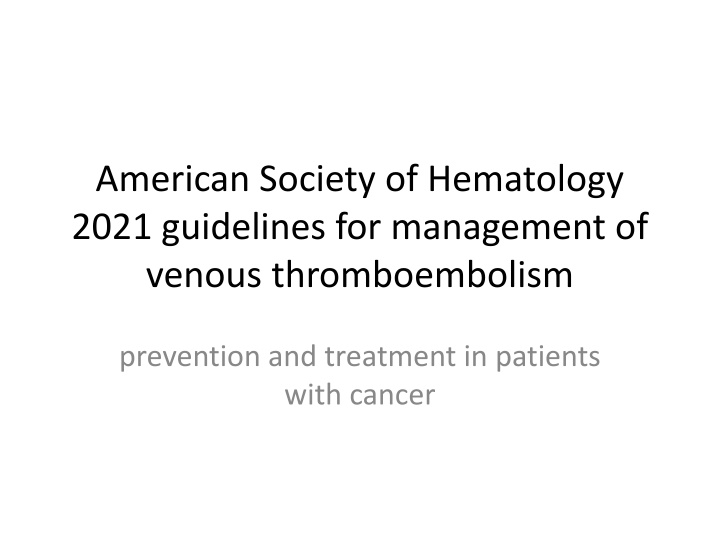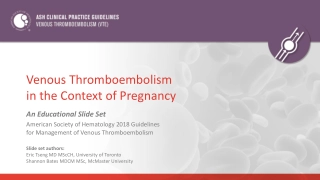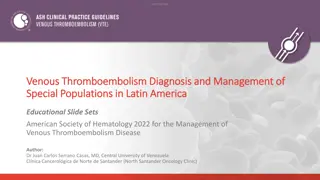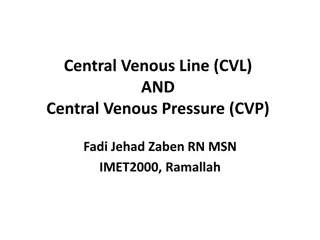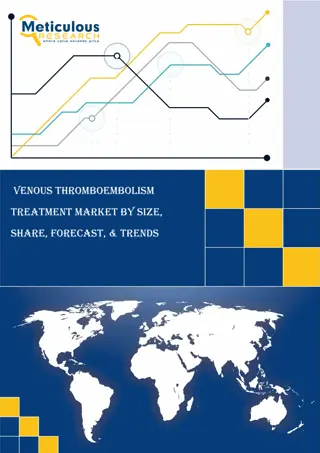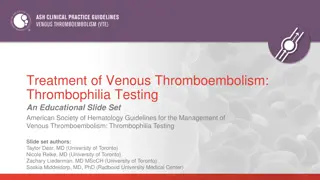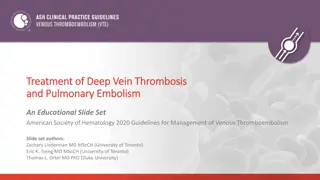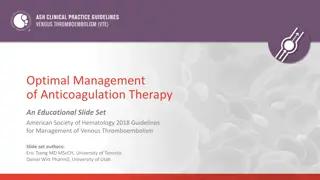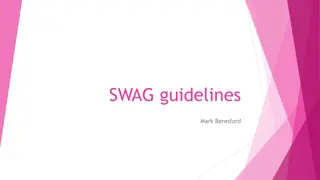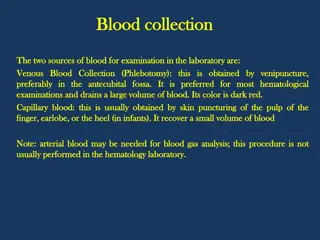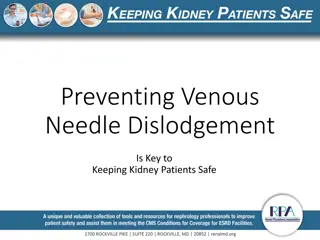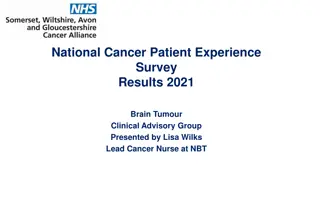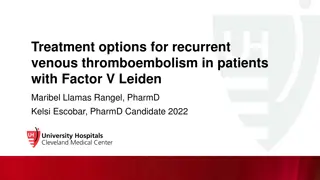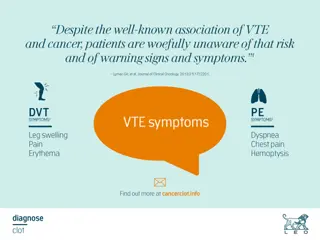American Society of Hematology 2021 Guidelines for Venous Thromboembolism in Cancer Patients
The American Society of Hematology (ASH) 2021 guidelines provide recommendations for preventing and treating venous thromboembolism (VTE) in cancer patients. The guidelines cover primary prophylaxis for hospitalized medical patients and those undergoing surgery, emphasizing the use of thromboprophylaxis, choice of pharmacological agents, and discontinuation strategies based on patient risk factors. Recommendations are made regarding the use of thromboprophylaxis over no prophylaxis and the selection of anticoagulants in various clinical scenarios. These evidence-based suggestions aim to improve clinical outcomes and safety in this vulnerable patient population.
Download Presentation

Please find below an Image/Link to download the presentation.
The content on the website is provided AS IS for your information and personal use only. It may not be sold, licensed, or shared on other websites without obtaining consent from the author.If you encounter any issues during the download, it is possible that the publisher has removed the file from their server.
You are allowed to download the files provided on this website for personal or commercial use, subject to the condition that they are used lawfully. All files are the property of their respective owners.
The content on the website is provided AS IS for your information and personal use only. It may not be sold, licensed, or shared on other websites without obtaining consent from the author.
E N D
Presentation Transcript
American Society of Hematology 2021 guidelines for management of venous thromboembolism prevention and treatment in patients with cancer
Primary prophylaxis for hospitalized medical patients with cancer RECOMMENDATION 1. For hospitalized medical patients with cancer without VTE, the American Society of Hematology (ASH) guideline panel suggests using thromboprophylaxis over no thromboprophylaxis (conditional recommendation, very low certainty in the evidence of effects ). RECOMMENDATION 2. For hospitalized medical patients with cancer without VTE, in which pharmacological thromboprophylaxis is used, the ASH guideline panel suggests using LMWH over UFH (conditional recommendation, low certainty in the evidence of effects ). RECOMMENDATION 3. For hospitalized medical patients with cancer without VTE, the ASH guideline panel suggests using pharmacological thromboprophylaxis over mechanical thromboprophylaxis (conditional recommendation, very low certainty in the evidence of effects ).
RECOMMENDATION 4. For hospitalized medical patients with cancer without VTE, the ASH guideline panel suggests using pharmacological thromboprophylaxis over a combination of pharmacological and mechanical thromboprophylaxis (conditional recommendation, very low certainty in the evidence of effects ). RECOMMENDATION 5. For hospitalized medical patients with cancer, the ASH guideline panel suggests discontinuing thromboprophylaxis at the time of hospital discharge rather than continuing thromboprophylaxis beyond the discharge date (conditional recommendation, very low certainty in the evidence of effects ).
Primary prophylaxis for patients with cancer undergoing surgery RECOMMENDATION 6. For patients with cancer without VTE undergoing a surgical procedure at lower bleeding risk, the ASH guideline panel suggests using pharmacological rather than mechanical thromboprophylaxis (conditional recommendation, low certainty in the evidence of effects ). RECOMMENDATION 7. For patients with cancer without VTE undergoing a surgical procedure at high bleeding risk, the ASH guideline panel suggests using mechanical rather than pharmacological thromboprophylaxis (conditional recommendation, low certainty in the evidence of effects ).
RECOMMENDATION 8. For patients with cancer without VTE undergoing a surgical procedure at high risk for thrombosis, except in those at high risk of bleeding, the ASH guideline panel suggests using a combination of mechanical and pharmacologic thromboprophylaxis rather than mechanical prophylaxis alone (conditional recommendation based on low certainty in the evidence of effects) or pharmacologic thromboprophylaxis alone (conditional recommendation, very low certainty in the evidence of effects ). RECOMMENDATION 9. For patients with cancer undergoing a surgical procedure, the ASH guideline panel suggests using LMWH or fondaparinux for thromboprophylaxis rather than UFH (conditional recommendation, low certainty in the evidence of effects ). RECOMMENDATION 10. For patients with cancer undergoing a surgical procedure, the ASH guideline panel makes no recommendation on the use of VKA or DOAC for thromboprophylaxis, because there were no studies available.
RECOMMENDATION 11. For patients with cancer undergoing a surgical procedure, the ASH guideline panel suggests using postoperative thromboprophylaxis over preoperative thromboprophylaxis (conditional recommendation, low certainty in the evidence of effects ). RECOMMENDATION 12. For patients with cancer who had undergone a major abdominal/pelvic surgical procedure, the ASH guideline panel suggests continuing pharmacological thromboprophylaxis post discharge rather than discontinuing at the time of hospital discharge (conditional recommendation, very low certainty in the evidence of effects ).
Primary prophylaxis in ambulatory patients with cancer receiving systemic therapy RECOMMENDATION 13. For ambulatory patients with cancer at low risk for thrombosis receiving systemic therapy, we recommend no thromboprophylaxis over parenteral thromboprophylaxis (strong recommendation, moderate certainty in the evidence of effects ). For ambulatory patients with cancer at intermediate risk for thrombosis receiving systemic therapy, the ASH guideline panel suggests no prophylaxis over parenteral prophylaxis (conditional recommendation, moderate certainty in the evidence of effects ). For ambulatory patients with cancer at high risk for thrombosis receiving systemic therapy, the ASH guideline panel suggests parenteral thromboprophylaxis (LMWH) over no thromboprophylaxis (conditional recommendation, moderate certainty in the evidence of effects ).
RECOMMENDATION 14. For ambulatory patients with cancer receiving systemic therapy, the ASH guideline panel recommends no thromboprophylaxis over oral thromboprophylaxis with VKA (strong recommendation, very low certainty in the evidence of benefits , but high certainty about the harms ). RECOMMENDATION 15. For ambulatory patients with cancer at low risk for thrombosis receiving systemic therapy, the ASH guideline panel suggests no thromboprophylaxis over oral thromboprophylaxis with a DOAC (apixaban or rivaroxaban) (conditional recommendation, moderate certainty in the evidence of effects ). For ambulatory patients with cancer at intermediate risk for thrombosis receiving systemic therapy, the ASH guideline panel suggests thromboprophylaxis with a DOAC (apixaban or rivaroxaban) or no thromboprophylaxis (conditional recommendation, moderate certainty in the evidence of effects ).
For ambulatory patients with cancer at high risk for thrombosis receiving systemic therapy, the ASH guideline panel suggests thromboprophylaxis with a DOAC (apixaban or rivaroxaban) over no thromboprophylaxis (conditional recommendation, moderate certainty in the evidence of effects ). RECOMMENDATIONS 16 AND 17. For multiple myeloma patients receiving lenalidomide, thalidomide, or pomalidomide-based regimens, the ASH guideline panel suggests using low-dose acetylsalicylic acid (ASA) or fixed low-dose VKA or LMWH (conditional recommendation, low certainty in the evidence of effects ).
Primary prophylaxis for patients with cancer with central venous catheter RECOMMENDATION 18. For patients with cancer and a central venous catheter (CVC), the ASH guideline panel suggests not using parenteral thromboprophylaxis (conditional recommendation, low certainty in the evidence of effects ). RECOMMENDATION 19. For patients with cancer and a CVC, the ASH guideline panel suggests not using oral thromboprophylaxis (conditional recommendation, low certainty in the evidence of effects ).
Initial treatment (first week) for patients with active cancer and VTE RECOMMENDATION 20. For patients with cancer and VTE, the ASH guideline panel suggests DOAC (apixaban or rivaroxaban) or LMWH be used for initial treatment of VTE for patients with cancer (conditional recommendation, very low certainty in the evidence of effects ). RECOMMENDATION 21. For patients with cancer and VTE, we recommend LMWH over UFH for initial treatment of VTE for patients with cancer (strong recommendation, moderate certainty in the evidence of effects ). RECOMMENDATION 22. For patients with cancer and VTE, the ASH guideline panel suggests LMWH over fondaparinux for initial treatment of VTE for patients with cancer (conditional recommendation, very low certainty in the evidence of effects ).
Short-term treatment for patients with active cancer (initial 3-6 months) RECOMMENDATION 23. For the short-term treatment of VTE (3-6 months) for patients with active cancer, the ASH guideline panel suggests DOAC (apixaban, edoxaban, or rivaroxaban) over LMWH (conditional recommendation, low certainty in the evidence of effects ). RECOMMENDATION 24. For the short-term treatment of VTE (3-6months) for patients with active cancer, the ASH guideline panel suggests DOAC (apixaban, edoxaban, or rivaroxaban) over VKA (conditional recommendation, very low certainty in the evidence of effects ).
RECOMMENDATION 25. For the short-term treatment of VTE (3-6 months) for patients with active cancer, the ASH guideline panel suggests LMWH over VKA (conditional recommendation, moderate certainty in the evidence of effects ). RECOMMENDATION 26. For patients with cancer and incidental (unsuspected) pulmonary embolism (PE), the ASH guideline panel suggests short-term anticoagulation treatment rather than observation (conditional recommendation, very low certainty in the evidence of effects ). RECOMMENDATION 27. For patients with cancer and sub segmental PE (SSPE), the ASH guideline panel suggests short-term anticoagulation treatment rather than observation (conditional recommendation, very low certainty in the evidence of effects ).
RECOMMENDATION 28. For patients with cancer and visceral/splanchnic vein thrombosis, the ASH guideline panel suggests treating with short-term anticoagulation or observing (conditional recommendation, very low certainty in the evidence of effects ). RECOMMENDATION 29. For patients with cancer with CVC-related VTE receiving anticoagulant treatment, the ASH guideline panel suggests keeping the CVC over removing the CVC (conditional recommendation, very low certainty in the evidence of effect ).
RECOMMENDATION 30. For patients with cancer and recurrent VTE despite receiving therapeutic LMWH, the ASH guideline panel suggests increasing the LMWH dose to a supratherapeutic level or continuing with a therapeutic dose (conditional recommendation, very low certainty in the evidence of effects ). RECOMMENDATION 31. For patients with cancer and recurrent VTE despite anticoagulation treatment, the ASH guideline panel suggests not using an inferior vena cava (IVC) filter over using a filter (conditional recommendation, very low certainty in the evidence of effects ).
Long-term treatment (>6 months) for patients with active cancer and VTE RECOMMENDATION 32. For patients with active cancer and VTE, the ASH guideline panel suggests long-term anticoagulation for secondary prophylaxis (more than 6 months) rather than short-term treatment alone (3-6 months) (conditional recommendation, low certainty in the evidence of effects ).
RECOMMENDATION 33. For patients with active cancer and VTE receiving long-term anticoagulation for secondary prophylaxis, the ASH guideline panel suggests continuing indefinite anticoagulation over stopping after completion of a definitive period of anticoagulation (conditional recommendation, very low certainty in the evidence of effects ). RECOMMENDATION 34. For patients with active cancer and VTE requiring long-term anticoagulation (more than 6 months), the ASH guideline panel suggests using DOACs or LMWH (conditional recommendation, very low certainty in the evidence of effects ).
Conclusions Strong recommendations include not using thromboprophylaxis in ambulatory patients receiving cancer chemotherapy at low risk of VTE and to use low-molecular-weight heparin (LMWH) for initial treatment of VTE in patients with cancer.
Conditional recommendations include using thromboprophylaxis in hospitalized medical patients with cancer, LMWH or fondaparinux for surgical patients with cancer, LMWH or direct oral anticoagulants (DOAC) in ambulatory patients with cancer receiving systemic therapy at high risk of VTE and LMWH or DOAC for initial treatment of VTE, DOAC for the short-term treatment of VTE, and LMWH or DOAC for the long-term treatment of VTE in patients with cancer.
